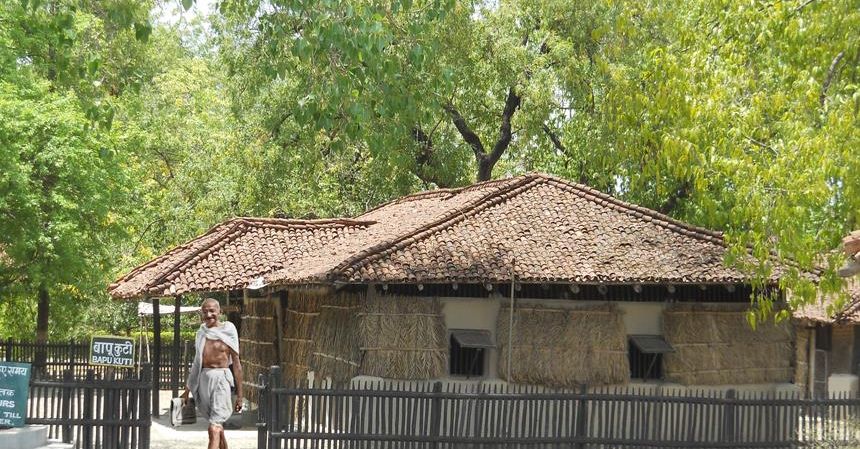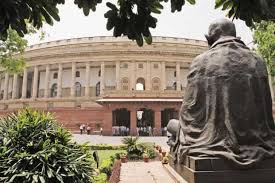The Evolution of Mohandas to Mahatma through Ashram Experiments
Gandhi was an ever evolving personality
Gandhi was an ever changing personality and he evolved his personality and thoughts through experiments in various Ashrams established by him, writes an eminent Gandhian scholar Siby K Joseph.
Siby K. Joseph

Long back I had the opportunity to make a cover design of a book written by my senior colleague Ram Chandra Pradhan viz.Integrating Body, Mind and Heart: The Gandhian Way. In the cover design, we depicted the theme through photos of Phoenix, Satyagraha and Sevagram Ashrams because these ashrams were spiritual laboratories for the integration of harmonious development of body, mind and spirit.
A cursory look at photos of the ashrams clearly shows the evolution of his mind and ideas. Through his experiments in Ashram life he could achieve the goal of integration of body, mind and spirit and making individuals as perfect instruments of service. It was the result of his spiritual Sadhana. So a meditative posture of Gandhi was superimposed on the cover page. It was duly approved by the author and Trinity Press who published it. Here we will analyze the evolution of his ideas on Ashram life in the different phases of his life.

The ashrams established by Gandhi were the result of a particular historical context in his eventful journey of public life and action. It would be interesting to analyze how Gandhi perfected his ideas on community living through his experiments. Young Mohandas went to South Africa in search of better prospects as a lawyer. Even after the completion of his work he could not come back because he decided to fight against racial discrimination.
Communitarian life
It resulted in the establishment of Natal Indian Congress and subsequently Indian Opinion- a mouthpiece of the Indian community. Gandhi started his first experimental community viz. Phoenix Settlement near Durban to practice the ideals he found in John Ruskin’s Unto this Last and to run Indian Opinion which was facing a financial crisis. When he started this communitarian life in 1904 he thought that co-workers would live as family and have children. He did not then think about brahmacharya .This could be considered as the first phase.
The Second Phase – Brahmacharya
The second phase we can trace when Gandhi took vow brahmacharya and discovered a new method of nonviolent struggle which he later called as Satyagraha. Gandhi himself wrote “The second step was taken in 1906. I learnt in the school of experience that brahmacharya was a sine qua non for a life devoted to service. From this time onward I looked upon Phoenix deliberately as a religious institution. The same year witnessed the advent of Satyagraha which was based on religion and implied an unshakable faith in the God of Truth. Religion here should not be understood in a narrow sense, but as that which acts as a link between different religions and realizes their essential unity.” From here one can witness the gradual progress of community life to Ashram life. At this stage it progressed in spiritual lines although it was not called an Ashram.
The Third Phase – Tolstoy Farm
The third phase began when he established Tolstoy Farm in 1910 near Johannesburg to accommodate Satyagraha families. Both Gandhi and Herman Kallenbach, who were the pillars of the Tolstoy Farm, were already following a sort of ashram life. Tolstoy Farm was visualized as an ashram where Satyagrahi families could live irrespective of their religious faith and lead religious or spiritual life. The ashramic life gave the inner strength for Mohandas towards his gradual journey towards Mahatmaship .
The Tolstoy farm differed from the Phoenix in many respects. In the Phoenix community the inmates were given an acre of land each, a house, and a monthly allowance of £ 3 per month for working in the press and a share of the profits. But in the Tolstoy Farm it was “cooperative commonwealth.” Everyone had only shared accommodation but separately both for men and women. In Phoenix each one was cultivating a separate plot of land, but in the Tolstoy Farm it was joint cultivation which ensured economy in production and fostered community spirit. No servants were called for household work, farming or even building operations. From cooking to scavenging every work was done by inmates. There was only one single kitchen and everyone dined together. It literally served as a “centre of spiritual purification and penance” When the Farm was closed the settlers went to Phoenix and followed the same ashramic life. Congregational prayer was conducted in both Phoenix Settlement and Tolstoy Farm and he continued it throughout his life. It was a source of strength for Gandhi and his inmates and provided food for soul.
The Fourth Phase – Ahmedabad
The fourth phase began in India when he settled in Ahmedabad . On the basis of consultations and discussions he arrived at the name Satyagraha Ashram. Gandhi wrote “It is an appropriate name if we take its object into consideration. My life is devoted to the quest of truth. I would live and if need be, die in prosecuting it, and of course I would take with me as many fellow-pilgrims as I could get.” In this phase, Gandhi placed before inmates the vows one has to follow in order to become perfect instruments in the pursuit of truth. While staying in Kocharab he realized a Bungalow like this was not suitable for an ashram. He wrote “an Ashram without orchard, farm or cattle would not be a complete unit.” He later shifted to the banks of river Sabarmati in a simple and austere setting. In the course of time he took the leadership of the country and his ashram became a laboratory for combat and constructive action for the attainment of Swaraj.
The Last Phase – Sevagram
The last phase of his Ashram was at Sevagram , a typical Maharashtrian village . Initially in this phase his idea was not keeping Ashram as a separate community away from the village but convert the whole village into an Ashram. But in the course of time it became a full-fledged Ashram. His insistence on building his hut for Rs. 100 using local materials shows his intense desire to identify with the villagers and village life.
He explained to his Polish engineer friend Maurice Frydman why he was in a village like Sevagram with bare minimum facilities: “I am here to serve no one else but myself, to seek my own self- realisation through the service of these village folk…. The service to human beings becomes a necessary part of the endeavour, simply because the only way to find God is to see Him in his creation and try to be one with it. This can only be done by service to all. “In this phase his emphasis was on constructive action along with combat.
Gandhi was an ever evolving personality and ashramic life both in South Africa and India played an important role in his personal evolution from an Inner Temple lawyer to Mahatma or Bapu of common masses. The greatest contribution of Gandhi is that through his community experiments he changed the very notion of the Ashram which was far away from mundane life. James D. Hunt, Gandhi scholar from America aptly said “ The Gandhian communities never were retreats from the world; they were attempts to change the world.”

.
About the Author
Dr. Siby K. Joseph is a noted academic and Gandhian Scholar having more than two decades of teaching and research experience. The books written and edited by him were published by Routledge, Concept, Manohar and many other publishing houses. His most recent writings are Lanza del Vasto: A Messenger of Peace (2018) Gandhi in South Africa: A Racist or A Liberator? (2019) Kasturba Gandhi: An Embodiment of Empowerment (2020).This Article is a part of series of articles on Ashrams established by Mahatma Gandhi.
Dr. Siby K. Joseph is Director, Sri Jamnalal Bajaj Memorial Library and Research Centre, Sevagram Ashram Pratishthan, Wardha-442102, Maharashtra.
Email:directorjbmlrc@gmail.com





